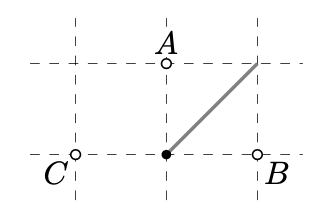1.10: Congruent triangles
- Page ID
- 56591
\( \newcommand{\vecs}[1]{\overset { \scriptstyle \rightharpoonup} {\mathbf{#1}} } \)
\( \newcommand{\vecd}[1]{\overset{-\!-\!\rightharpoonup}{\vphantom{a}\smash {#1}}} \)
\( \newcommand{\dsum}{\displaystyle\sum\limits} \)
\( \newcommand{\dint}{\displaystyle\int\limits} \)
\( \newcommand{\dlim}{\displaystyle\lim\limits} \)
\( \newcommand{\id}{\mathrm{id}}\) \( \newcommand{\Span}{\mathrm{span}}\)
( \newcommand{\kernel}{\mathrm{null}\,}\) \( \newcommand{\range}{\mathrm{range}\,}\)
\( \newcommand{\RealPart}{\mathrm{Re}}\) \( \newcommand{\ImaginaryPart}{\mathrm{Im}}\)
\( \newcommand{\Argument}{\mathrm{Arg}}\) \( \newcommand{\norm}[1]{\| #1 \|}\)
\( \newcommand{\inner}[2]{\langle #1, #2 \rangle}\)
\( \newcommand{\Span}{\mathrm{span}}\)
\( \newcommand{\id}{\mathrm{id}}\)
\( \newcommand{\Span}{\mathrm{span}}\)
\( \newcommand{\kernel}{\mathrm{null}\,}\)
\( \newcommand{\range}{\mathrm{range}\,}\)
\( \newcommand{\RealPart}{\mathrm{Re}}\)
\( \newcommand{\ImaginaryPart}{\mathrm{Im}}\)
\( \newcommand{\Argument}{\mathrm{Arg}}\)
\( \newcommand{\norm}[1]{\| #1 \|}\)
\( \newcommand{\inner}[2]{\langle #1, #2 \rangle}\)
\( \newcommand{\Span}{\mathrm{span}}\) \( \newcommand{\AA}{\unicode[.8,0]{x212B}}\)
\( \newcommand{\vectorA}[1]{\vec{#1}} % arrow\)
\( \newcommand{\vectorAt}[1]{\vec{\text{#1}}} % arrow\)
\( \newcommand{\vectorB}[1]{\overset { \scriptstyle \rightharpoonup} {\mathbf{#1}} } \)
\( \newcommand{\vectorC}[1]{\textbf{#1}} \)
\( \newcommand{\vectorD}[1]{\overrightarrow{#1}} \)
\( \newcommand{\vectorDt}[1]{\overrightarrow{\text{#1}}} \)
\( \newcommand{\vectE}[1]{\overset{-\!-\!\rightharpoonup}{\vphantom{a}\smash{\mathbf {#1}}}} \)
\( \newcommand{\vecs}[1]{\overset { \scriptstyle \rightharpoonup} {\mathbf{#1}} } \)
\( \newcommand{\vecd}[1]{\overset{-\!-\!\rightharpoonup}{\vphantom{a}\smash {#1}}} \)
\(\newcommand{\avec}{\mathbf a}\) \(\newcommand{\bvec}{\mathbf b}\) \(\newcommand{\cvec}{\mathbf c}\) \(\newcommand{\dvec}{\mathbf d}\) \(\newcommand{\dtil}{\widetilde{\mathbf d}}\) \(\newcommand{\evec}{\mathbf e}\) \(\newcommand{\fvec}{\mathbf f}\) \(\newcommand{\nvec}{\mathbf n}\) \(\newcommand{\pvec}{\mathbf p}\) \(\newcommand{\qvec}{\mathbf q}\) \(\newcommand{\svec}{\mathbf s}\) \(\newcommand{\tvec}{\mathbf t}\) \(\newcommand{\uvec}{\mathbf u}\) \(\newcommand{\vvec}{\mathbf v}\) \(\newcommand{\wvec}{\mathbf w}\) \(\newcommand{\xvec}{\mathbf x}\) \(\newcommand{\yvec}{\mathbf y}\) \(\newcommand{\zvec}{\mathbf z}\) \(\newcommand{\rvec}{\mathbf r}\) \(\newcommand{\mvec}{\mathbf m}\) \(\newcommand{\zerovec}{\mathbf 0}\) \(\newcommand{\onevec}{\mathbf 1}\) \(\newcommand{\real}{\mathbb R}\) \(\newcommand{\twovec}[2]{\left[\begin{array}{r}#1 \\ #2 \end{array}\right]}\) \(\newcommand{\ctwovec}[2]{\left[\begin{array}{c}#1 \\ #2 \end{array}\right]}\) \(\newcommand{\threevec}[3]{\left[\begin{array}{r}#1 \\ #2 \\ #3 \end{array}\right]}\) \(\newcommand{\cthreevec}[3]{\left[\begin{array}{c}#1 \\ #2 \\ #3 \end{array}\right]}\) \(\newcommand{\fourvec}[4]{\left[\begin{array}{r}#1 \\ #2 \\ #3 \\ #4 \end{array}\right]}\) \(\newcommand{\cfourvec}[4]{\left[\begin{array}{c}#1 \\ #2 \\ #3 \\ #4 \end{array}\right]}\) \(\newcommand{\fivevec}[5]{\left[\begin{array}{r}#1 \\ #2 \\ #3 \\ #4 \\ #5 \\ \end{array}\right]}\) \(\newcommand{\cfivevec}[5]{\left[\begin{array}{c}#1 \\ #2 \\ #3 \\ #4 \\ #5 \\ \end{array}\right]}\) \(\newcommand{\mattwo}[4]{\left[\begin{array}{rr}#1 \amp #2 \\ #3 \amp #4 \\ \end{array}\right]}\) \(\newcommand{\laspan}[1]{\text{Span}\{#1\}}\) \(\newcommand{\bcal}{\cal B}\) \(\newcommand{\ccal}{\cal C}\) \(\newcommand{\scal}{\cal S}\) \(\newcommand{\wcal}{\cal W}\) \(\newcommand{\ecal}{\cal E}\) \(\newcommand{\coords}[2]{\left\{#1\right\}_{#2}}\) \(\newcommand{\gray}[1]{\color{gray}{#1}}\) \(\newcommand{\lgray}[1]{\color{lightgray}{#1}}\) \(\newcommand{\rank}{\operatorname{rank}}\) \(\newcommand{\row}{\text{Row}}\) \(\newcommand{\col}{\text{Col}}\) \(\renewcommand{\row}{\text{Row}}\) \(\newcommand{\nul}{\text{Nul}}\) \(\newcommand{\var}{\text{Var}}\) \(\newcommand{\corr}{\text{corr}}\) \(\newcommand{\len}[1]{\left|#1\right|}\) \(\newcommand{\bbar}{\overline{\bvec}}\) \(\newcommand{\bhat}{\widehat{\bvec}}\) \(\newcommand{\bperp}{\bvec^\perp}\) \(\newcommand{\xhat}{\widehat{\xvec}}\) \(\newcommand{\vhat}{\widehat{\vvec}}\) \(\newcommand{\uhat}{\widehat{\uvec}}\) \(\newcommand{\what}{\widehat{\wvec}}\) \(\newcommand{\Sighat}{\widehat{\Sigma}}\) \(\newcommand{\lt}{<}\) \(\newcommand{\gt}{>}\) \(\newcommand{\amp}{&}\) \(\definecolor{fillinmathshade}{gray}{0.9}\)Our next goal is to give a rigorous meaning for (iv) on Section 1.1. To do this, we introduce the notion of congruent triangles so instead of “if we rotate or shift we will not see the difference” we say that for triangles, the side-angle-side congruence holds; that is, two triangles are congruent if they have two pairs of equal sides and the same angle measure between these sides.
An ordered triple of distinct points in a metric space \(\mathcal{X}\), say \(A, B, C\), is called a triangle \(ABC\) (briefly \(\triangle ABC\)). Note that the triangles \(ABC\) and \(ACB\) are considered as different.
Two triangles \(A'B'C'\) and \(ABC\) are called congruent (it can be written as \(\triangle A'B'C' \cong \triangle ABC\)) if there is a motion \(f: \mathcal{X} \to \mathcal{X}\) such that
\(A' = f(A)\), \(B' = f(B)\) and \(C' = f(C)\).
Let \(\mathcal{X}\) be a metric space, and \(f, g: \mathcal{X} \to \mathcal{X}\) be two motions. Note that the inverse \(f^{-1}: \mathcal{X} \to \mathcal{X}\), as well as the composition \(f \circ g: \mathcal{X} \to \mathcal{X}\) are also motions.
It follows that "\(\cong\)" is an equivalence relation; that is, any triangle congruent to itself, and the following two conditions hold:
- If \(\triangle A'B'C' \cong \triangle ABC\), then \(\triangle ABC \cong \triangle A'B'C'\).
- If \(\triangle A''B''C'' \cong \triangle A'B'C'\) and \(\triangle A'B'C' \cong \triangle ABC\), then
\[\triangle A''B''C'' \cong \triangle ABC.\]
Note that if \(\triangle A'B'C' \cong \triangle ABC\), then \(AB = A'B', BC = B'C'\) and \(CA = C'A'\).
For a discrete metric, as well as some other metrics, the converse also holds. The following example shows that it does not hold in the Manhattan plane:
Consider three points \(A = (0, 1), B = (1, 0)\), and \(C = (-1, 0)\) on the Manhattan plane \((\mathbb{R}^2, d_1)\). Note that
\[d_1 (A, B) = d_1 (A, C) = d_1 (B, C) = 2.\]
On one hand,
\(\triangle ABC \cong \triangle ACB.\)
Indeed, the map \((x, y) \mapsto (-x, y)\) is a motion of \((\mathbb{R}^2, d_1)\) that sends \(A \mapsto A, B \mapsto C\), and \(C \mapsto B\).
On the other hand,
\(\triangle ABC \not\cong \triangle BCA.\)

Indeed, arguing by contradiction, assume that \(\triangle ABC \cong \triangle BCA\); that is, there is a motion \(f\) of \((\mathbb{R}^2, d_1)\) that send \(A \mapsto B, B \mapsto C,\) and \(C \mapsto A\).
We say that \(M\) is a midpoint of \(A\) and \(B\) if
\(d_1(A, M) = d_1(B, M) = \dfrac{1}{2} \cdot d_1(A, B).\)
Note that a point \(M\) is a midpoint of \(A\) and \(B\) if and only if \(f(M)\) is a midpoint of \(B\) and \(C\).
The set of midpoints for \(A\) and \(B\) is infinite, it contains all points \((t, t)\) for \(t \in [0, 1]\) (it is the gray segment on the picture above). On the other hand, the midpoint for \(B\) and \(C\) is unique (it is the black point on the picture). Thus, the map \(f\) cannot be bijective — a contradiction.


